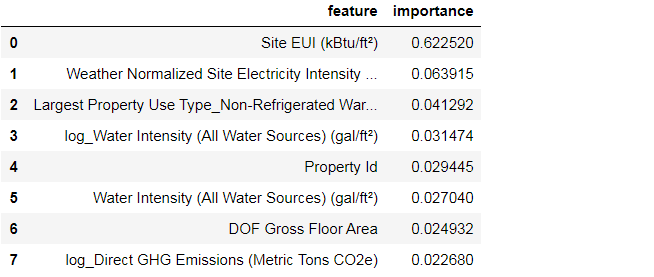接上一篇: [[ 机器学习项目实战-能源利用率2-建模 ]]
解释模型目录:
- * 导入建模数据
- 七. 解释模型
- 7.1 特征重要性
- 7.1.1 特征重要性排序
- 7.1.2 特征重要性95%
- 7.1.3 根据特征重要性筛选特征
- 7.1.4 检测效果
- 7.2 LIME
- 7.2.1 最差预测的解释
- 7.2.2 最好预测的解释
- 7.3 单棵树模型观察
* 导入建模数据
1
2
3
4
5
6
7
8
9
10
11
12
13
14
15
16
17
18
19
20
21
22
23
24
25
26
27
28
29
30
31
32
33
34
35
36
37
38
39
40
41
42
43
44
45
46import warning warning.filterwarning('ignore') import pandas as pd import numpy as np pd.options.mode.chained_assignment = None pd.set_option('display.max_columns', 50) import matplotlib.pyplot as plt import seaborn as sns %matplotlib inline plt.rcParams['font.size'] = 24 sns.set(font_scale = 2) train_features = pd.read_csv('data/training_features.csv') test_features = pd.read_csv('data/testing_features.csv') train_labels = pd.read_csv('data/training_labels.csv') test_labels = pd.read_csv('data/testing_labels.csv') from sklearn.importer import SimpleImputer imputer = SimpleImputer(strategy = 'median') imputer.fit(train_features) X = imputer.transform(train_features) X_test = imputer.transform(test_features) from sklearn.preprocessing import MinMaxScaler minmax_scaler = MinMaxScaler().fit(X) X = minmax_scaler.transform(X) X_test = minmax_scaler.transform(X_test) y = np.array(train_labels).reshape((-1, )) y_test = np.array(test_labels).reshape((-1, )) def mae(y_true, y_pred): return np.mean(abs(y_true - y_pred)) from sklearn.ensemble import GradientBoostingRegressor model = GradientBoostingRegressor(loss = 'lad', max_depth = 6, max_features = None, min_samples_leaf = 4, min_samples_split = 10, e_estimators = 550, random_state = 42) model.fit(X, y) model_pred = model.predict(X_test) model_mae = mae(y_test, model_pred) print('Final Model Performance on the test set: MAE = %.4f' % model_mae)
Final Model Performance on the test set: MAE = 9.0963
七. 解释模型
- 特征重要性
- Locally Interpretable Model-agnostic Explainer (LIME)
- 建立一颗树模
7.1 特征重要性
sklearn中特征重要性的计算方法
在所有树模型中平均节点不纯度的减少
7.1.1 特征重要性排序
1
2
3
4
5feature_results = pd.DataFrame({'feature': list(train_features.columns), 'importance': model.feature_importances_}) feature_results = feature_results.sort_values('importance', ascending = False).reset_index(drop = True) feature_results.head(8)

1
2
3
4
5
6
7
8
9
10from IPython.core.pylabtools import figsize figsize(12, 10) plt.style.use('ggplot') feature_results.loc[:9, :].plot(x = 'feature', y = 'importance', edgecolor = 'k', kind = 'barh', color = 'blue') plt.xlabel('Relative Importance', fontsize = 18); plt.ylabel('') # plt.yticks(fontsize = 12); plt.xticks(fontsize = 14) plt.title('Feature Importances from Random Forest', size = 26)

7.1.2 特征重要性95%
1
2
3
4
5
6
7
8
9
10cumulative_importances = np.cumsum(feature_results['importance']) plt.figure(figsize = (20, 6)) plt.plot(list(range(feature_results.shape[0])), cumulative_importances.values, 'b-') plt.hlines(y=0.95, xmin=0, xmax=feature_results.shape[0], color='r', linestyles='dashed') # plt.xticks(list(range(feature_results.shape[0])), feature_results.feature, rotation=60) plt.xlabel('Feature', fontsize = 18) plt.ylabel('Cumulative importance', fontsize = 18) plt.title('Cumulative Importances', fontsize = 26)

1
2
3most_num_importances = np.where(cumulative_importances > 0.95)[0][0] + 1 print('Number of features for 95% importance: ', most_num_importances)
Number of features for 95% importance: 13
7.1.3 根据特征重要性筛选特征
1
2
3
4
5
6
7
8most_important_features = feature_results['feature'][:13] indices = [list(train_features.columns).index(x) for x in most_important_features] X_reduced = X[:, indices] X_test_reduced = X_test[:, indices] pirnt('Most import training features shape: ', X_reduced.shape) print('Most import testing feature shape: ', X_test_reduced.shape)
Most import training features shape: (6622, 13)
Most import testing features shape: (2839, 13)
7.1.4 检测效果
1
2
3
4
5
6
7
8
9
10
11
12
13
14
15
16
17
18
19
20
21
22
23
24from sklearn.ensemble import RandomForestRegressor rfr = RandomForestRegressor(random_state = 42) rfr.fit(X, y) rfr_full_pred = rfr.predict(X_test) rfr.fit(X_reduced, y) rfr_reduced_pred = rfr.predict(X_test_reduced) print('Random Forest Full Results: MAE = %.4f.' % mae(y_test, rfr_full_pred)) print('Random Forest Reduced Results: MAE = %.4f.' % mae(y_test, rfr_reduced_pred)) from sklearn.linear_model import LinearRegression lr = LinearRegression() lr.fit(X, y) lr_full_pred = lr.predict(X_test) lr.fit(X_reduced, y) lr_reduced_pred = lr.predict(X_test_reduced) print('Linear Regression Full Results: MAE = %.4f.' % mae(y_test, lr_full_pred)) print('Linear Regression Reduced Results: MAE = %.4f.' % mae(y_test, lr_reduced_pred))
Random Forest Full Results: MAE = 9.9025.
Random Forest Reduced Results: MAE = 10.3780.
Linear Regression Full Results: MAE = 13.4651.
Linear Regression Reduced Results: MAE = 14.3103.
- 试验结果发现效果还不如原来
1
2
3
4
5
6
7
8model_reduced = GradientBoostingRegressor(loss = 'lad', max_depth = 6, max_features = None, min_samples_leaf = 4, min_samples_split = 10, n_estimators = 550, random_state = 42) model_reduced.fit(X_reduced, y) model_reduced_pred = model_reduced.predict(X_test_reduced) print('Gradient Boosting Reduced Results: MAE = %.4f.' % mae(y_test, model_reduced_pred))
Gradient Boosting Reduced Results: MAE = 9.3899.
- 在GBDT中出现了同样的问题,所以不选择去掉部分小价值特征。
7.2 LIME
Locally Interpretable Model-agnostic Explanations
地址:LIME to explain individual predictions
分别选择一个预测最好的和预测最差的来分别解释
7.2.1 最差预测的解释
1
2
3
4
5
6
7
8
9
10
11
12
13
14
15
16
17
18
19
20
21
22
23import lime import lime.lime_tabular residuals = abs(model_reduced_pred - y_test) # 残差 wrong = X_test_reduced[np.argmax(residuals), :] # 最差的预测 right = X_test_reduced[np.argmin(residuals), :] # 最好的预测 # 最差预测位置的预测值与真实值 print('Prediction: %.4f' % model_reduced.predict(wrong.reshape(1, -1))) print('Actual Value: %.4f' % y_test[np.argmax(residuals)]) # Create a lime explainer object explainer = lime.lime_tabular.LimeTabularExplainer(training_data = X_reduced, mode = 'regression', training_labels = y, feature_names = list(most_important_features)) # 最差预测的解释 wrong_exp = explainer.explain_instance(data_row = wrong, predict_fn = model_reduced.predict) # 预测的解释画图 wrong_exp.as_pyplot_figure() plt.title('Explanation of Prediction', fontsize = 24) plt.xlabel('Effect on Prediction', fontsize = 20)
Prediction: 11.6612
Actual Value: 96.0000

1
2wrong_exp.show_in_notebook(show_predicted_value = False)

预测值:11.66 实际值:96。这里面差距实在太大了,会不会存在什么问题呢?
上图展示了各个特征对结果的贡献程度,其中Site EUI使得结果值大大下降,由于该值(归一化后) 大于0.47了,正常情况下是能源利用率较低了,但是这里反而标签的得分很高,所以有理由认为,该数据点标签值存在问题。
7.2.2 最好预测的解释
1
2
3
4
5
6
7
8
9
10
11
12# 最好预测位置的预测值与真实值 print('Prediction: %0.4f' % model_reduced.predict(right.reshape(1, -1))) print('Actual Value: %0.4f' % y_test[np.argmin(residuals)]) # 最好预测的解释 right_exp = explainer.explain_instance(data_row = right, predict_fn = model_reduced.predict, num_features = 10) # 预测的解释画图 right_exp.as_pyplot_figure() plt.title('Explanation of Prediction', size = 26) plt.xlabel('Effect on Prediction', size = 20)
Prediction: 99.9975
Actual Value: 100.0000

1
2right_exp.show_in_notebook(show_predicted_value = False)

7.3 单棵树模型观察
1
2
3
4
5
6
7
8
9
10
11
12from sklearn import tree import pydotplus from IPython.display import display, Image single_tree = model_reduced.estimators_[100][0] dot_data = tree.export_graphviz(single_tree, out_file = None, rounded = True, feature_names = most_important_features, filled = True) graph = pydotplus.graph_from_dot_data(dot_data) graph.write_png('sigle_tree.png') display(Image(graph.creat_png()))

- 太密集了,限制下深度
1
2
3
4
5
6dot_data = tree.export_graphviz(single_tree, out_file = None, rounded = True, max_depth = 3, feature_names = most_important_features, filled = True) graph = pydotplus.graph_from_dot_data(dot_data) graph.write_png('sigle_tree.png') display(Image(graph.create_png()))

最后
以上就是饱满咖啡豆最近收集整理的关于机器学习项目实战-能源利用率3-分析的全部内容,更多相关机器学习项目实战-能源利用率3-分析内容请搜索靠谱客的其他文章。








发表评论 取消回复